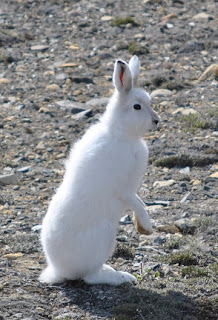Zoe Panchen
I have just got back from Lake Hazen, Ellesmere Island after spending the last 7 weeks studying plant phenology there. At Camp Hazen, where I was based, the only methods of communication were via radio and satellite. There was definitely no internet access in such a remote location so I have accumulated many stories to tell and photos to share. Here is the first of several posts on my work and my wonderful experience at Lake Hazen (sign up to receive an email when there is a new post at the bottom of this page).
 |
| Camp Hazen on the shores Lake Hazen with McGill Mountain rising 1000m above camp. I took the photo when I walked out across the frozen lake to Johns Island about 1.5km out on the lake a few days after I arrived in early June. |
Lake Hazen is 60km long and located in the centre of Quttinirpaaq National Park at the very north of Ellesmere Island. Half way along the lake on the north shore is the Camp Hazen warden station where I stayed. The camp was originally set up by the Defence Research Board in 1957 for the"Operation Hazen" scientific studies that were part of the International Geophysical Year. Rising 1000m above camp to the north are McGill, Omingmak (Inuktitut for Muskox) and Varsity Mountains. To the north of these mountains is the vast icecap of Northern Ellesmere Island and beyond that......the Arctic Ocean and the North Pole.
 |
| I took this photo of Camp Hazen at close to midnight but it could have been midday it was so bright with the midnight sun! The green tent on the right is the original 1957 Operation Hazen Atwell tent, where 4 McGill students spent the winter recording the weather - it hovered around -40C! It is now the cook tent complete with gas stove, gas fridge and tank for water pumped from the lake. The two white sleeper tents were installed a couple of years ago. The vertical box by the aerial is the shower equipped with a shower bag but the sun was never warm enough to heat the water in the black bag and anyway it was too cool for showering al fresco so we contented ourselves with "sink washes". On the left is the emergency shelter with radio. |
Camp Hazen is so far north, just 9 degrees of latitude to the north pole, that the sun is high in the sky 24-7. In fact the lighting for photography was the best at midnight. The sun came streaming through my window at night. Some of the park staff would cover the window to create some semblance of dark but I preferred to keep my window uncovered to experience the uniqueness of the midnight sun.
 |
| The Twin Otter plane leaving after dropping myself and park staff at Lake Hazen with Varsity Mountain in the back ground. We flew by Twin Otter from Resolute (which, along with Grise Fiord, are the most northerly communities in Canada) stopping to refuel 3hrs later at the Eureka Weather Station, dropping park staff at Tanquary Fiord warden station 1hr later and finally arriving at Lake Hazen 1/2hr later. Just to give an idea of how far north and how far from civilisation we were, each stop was virtually due north of the last stop. By mid July all the snow in this picture had melted. |
The area was truly a remote and vast wilderness, no roads for hundreds of miles, not even a foot trail; no people, just the odd herd of Muskox passing by; total silence or at most the sound of the wind or birds calling. It was an amazingly exhilarating feeling striding out across the tundra and up the mountainsides to my study sights.
 |
| Candled ice beached by wind action on the shore near camp Hazen |
Lake Hazen was completely covered with ice and safe for skidoo travel until early July. In mid July a ring of water appeared around the lake edges by which time the ice had changed to candled ice. We could hear chandelier like tinkling as the ice slowly disintegrated. Depending on the direction of the wind, the sheets of candled ice would be blown up on to shore to form ice waves. Normally Lake Hazen is an oasis of calm with little wind but on the last couple of days of July a huge wind storm arrived and within 24hrs all of the 80% ice cover of the lake completely disappeared and there were waves lapping at the shore. We suspect that the wind action caused warmer water to be churned up and melt much of the ice. It was quite the transformation.
 |
Looking south from the slopes of McGill Mountain.
Camp Hazen is the tiny dots on the near shore of Lake Hazen with Johns Island behind.
I took this photo the day after the huge windstorm which changed the lake from 80% ice cover to 100% open water. |

























